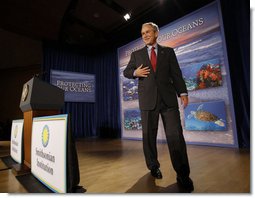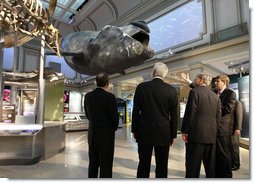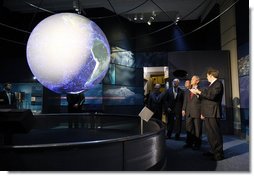
- Afghanistan
- Africa
- Budget Management
- Defense
- Economy
- Education
- Energy
- Environment
- Global Diplomacy
- Health Care
- Homeland Security
- Immigration
- International Trade
- Iraq
- Judicial Nominations
- Middle East
- National Security
- Veterans
|
Home >
News & Policies >
September 2008
|
For Immediate Release
Office of the Press Secretary
September 26, 2008
President Bush Discusses U.S. Ocean Action Plan
Smithsonian Museum of Natural History
Washington, D.C.
![]() In Focus: Environment
In Focus: Environment
![]() Fact Sheet: Protecting Our Oceans
Fact Sheet: Protecting Our Oceans
10:15 A.M. EDT
THE PRESIDENT: Thank you, all. Thank you, Secretary Clough, for the introduction. And congratulations on the opening of the Sant Ocean Hall -- which, by the way, opens tomorrow morning at 11:00 a.m. The Secretary and I just had a fabulous tour. These exhibits in this hall will remind people that our oceans are vital for our planet -- this is going to heighten awareness of how important our oceans are and that we have a solemn duty to protect them.
 And so I've come not only to see the hall and to herald its opening, but to
spend a little time talking about ocean conservation. There are a lot of
people in this room who care about ocean conservation, and I appreciate you
working with us to help preserve a vital natural resource.
And so I've come not only to see the hall and to herald its opening, but to
spend a little time talking about ocean conservation. There are a lot of
people in this room who care about ocean conservation, and I appreciate you
working with us to help preserve a vital natural resource.
First of all, I do want to recognize the Chancellor of the Smithsonian Institute's Board of Regents -- I call him the Chief Justice of the Supreme Court -- Justice Roberts, thank you for coming. (Applause.) I appreciate very much the Sant family -- Roger and Vicki; Roger turns out to be the Chairman of the Institute's Board of Regents, and a big supporter, obviously, of the Smithsonian, otherwise they probably wouldn't have named the hall for him. (Laughter.) But thank you for your generosity and your support. (Applause.)
Cristian Samper is the Director of the Smithsonian Museum of Natural History, and he gave us a tour today and he's a knowledgeable fellow, a biologist, and he will make sure that these exhibits remain relevant for the -- you know, for the education of the American people. And I want to than you, Cristian, for your service.
I'm proud to be here with a member of my Cabinet, Carlos Gutierrez, Department of Commerce, which oversees NOAA, which had something to do with this facility. I want to thank Congresswoman Madeleine Bordallo -- there she is, Madeleine, good to see you, thank you for coming. She is from Guam. I appreciate the winners of the National Ocean Art Contest who are here today -- that would be you all. (Applause.)
I'm about to talk about some policy we've been implementing, and I want to thank all those in the room for helping. There's a lot of folks around the country and here in Washington who care deeply about the oceans. And many of the organizations that have worked constructively with our administration are here, and I thank you for your efforts -- because the truth of the matter is that we have got a good record working with you. And I want to share some thought about it.
First of all, you got to know I like oceans. I didn't grow up in the ocean -- as a matter of fact -- near the ocean -- I grew up in the desert. Therefore, it was a pleasant contrast to see the ocean. And I particularly like it when I'm fishing. It turns out it's a -- I'm not the first President likes to fish. It turns out the first President really liked to fish. George Washington -- I was reading where he one time caught 100,000 herring in a single day. That's either a lot of fish or a lot of fishing. (Laughter.) But unlike that George W., I have not had that kind of luck before. (Laughter.)
 America is a maritime nation. Obviously the -- protecting the oceans are
in our interest. It turns out that commercial and recreational fishing add
more than $76 billion to our economy every year. Seaport-related
businesses add an estimated $2 trillion in economic activity. And the
oceans are important for our economic -- you know, as an economic lifeline.
They're important to our economy. Seas also offer limitless opportunities
for recreation and transportation and education and research. It all adds
up to the fact we got to be good stewards.
America is a maritime nation. Obviously the -- protecting the oceans are
in our interest. It turns out that commercial and recreational fishing add
more than $76 billion to our economy every year. Seaport-related
businesses add an estimated $2 trillion in economic activity. And the
oceans are important for our economic -- you know, as an economic lifeline.
They're important to our economy. Seas also offer limitless opportunities
for recreation and transportation and education and research. It all adds
up to the fact we got to be good stewards.
And so we developed what we call the Ocean Action Plan. I'm a guy who likes -- when people walk into my office, I like to say, you know, what are the specific steps and how are we doing at achieving them? This particular plan started off with 88 different points of action, expectations -- we've met 87 of them. When the Senate passes a treaty, we will have met 88 of them. And it's -- (applause.)
Many of you in this room helped develop the plan, many of you helped implement the plan. And I thank you. The goal is to make our oceans' coast and Great Lakes cleaner, healthier, and more productive. I want to spend a little time talking about some of the successes.
Under the Ocean Action Plan we've worked to stop over-fishing. Last year, I issued an executive order protecting two of our nation's most popular game fish -- striped bass and red drum. I signed important legislation reauthorizing the Magnuson Stevenson [sic] Act, which sets a firm deadline to end over-fishing in America by 2011. Many in this hall helped pass that piece of legislation and I thank you. Thanks to these and other efforts, we are beginning to see progress toward ending over-fishing.
 At the beginning of my administration, 44 fish stocks were listed as
over-fished. Today, almost half of those stocks are no longer on the list.
That's good news. Along the way, we've stepped up our efforts to identify
additional fish stocks that are at risk -- and we're going to take steps to
protect them.
At the beginning of my administration, 44 fish stocks were listed as
over-fished. Today, almost half of those stocks are no longer on the list.
That's good news. Along the way, we've stepped up our efforts to identify
additional fish stocks that are at risk -- and we're going to take steps to
protect them.
We're protecting and restoring vital wetland and marine habitats. In 2004, I set a goal of restoring, improving, and protecting 3 million acres of interior and coastal wetlands in five years; we have met that goal one year ahead of schedule. This effort includes our watershed restoration project in the Florida Everglades, which is the largest in the world. During my administration, we have put two-thirds of federal waters -- about 2.3 million square nautical miles -- off-limits to harmful bottom-trawling and dredging. We care what happens in the oceans.
We made a special effort to protect the tropical forests of the sea: coral reefs. Some of the most spectacular reefs are found in the Northwestern Hawaiian Islands Marine National Monument, which I created in June of 2006, thanks to the efforts of many in this hall. This monument is the world's largest fully protected marine conservation area, and it covers more than 7,000 marine species -- a quarter of which are found nowhere else on Earth.
It's promoted a culture of cooperative conservation. Through programs like the Coastal America Partnership, we joined with state and local governments, fishermen, and tribal leaders, and tens of thousands of volunteers to improve conservation from the Great Lakes to the Gulf Coast. One project which is dear to my heart is when folks from the private sector helped to restore 10,000 acres of tidal wetlands in my home state. For decades this area could be the equivalent of a dust bowl, just neglected. Today it's a thriving ecosystem, filled with shorebirds and abundant fish.
Cooperative conservation works. It makes sense. It's a strategy that's easy to implement when you find people willing to step up and do their part.
We're increasing international cooperation to protect the ocean environment that affects all nations. Through the Coral Triangle Initiative, we're working with nations like Indonesia, and Malaysia, and the Philippines, and Australia to identify and eliminate the threats to tropical reefs. President Yudhoyono of Indonesia gets a lot of credit for this initiative. He is bound and determined to protect coral reefs around his nation, and we are bound and determined to help him do so, by providing money, strategy, expertise and encouragement. At the United Nations, we succeeded in passing a resolution to help protect fish stocks and marine habitats from destructive fishing practices.
 A lot of our citizens don't understand what's taking place in parts of the
world, but people use dynamite to fish, or they poison the fish stocks in
order to -- in order to net them, or they use destructive bottom trawling.
And we're using our influence to stop those kind of practices.
A lot of our citizens don't understand what's taking place in parts of the
world, but people use dynamite to fish, or they poison the fish stocks in
order to -- in order to net them, or they use destructive bottom trawling.
And we're using our influence to stop those kind of practices.
We're expanding ocean research. There is more left to learn about the oceans -- there's probably more to learn about the oceans than we need to learn about the moon -- or that we know about the moon. And so to help unlock these mysteries, we've launched a Ten-Year Ocean Research Priorities Plan. Research supported by the plan is helping to reduce shipping's impact on the environment, improve our understanding of important ocean conditions like red tides, teach us more about the oceans' role in climate change, and improve our ability to protect Americans from natural disasters like hurricanes and tsunamis.
We're expanding education programs to teach citizens more about the oceans. The truth of the matter is there's a knowledge gap between what scientists and biologists understand about oceans and what our citizens understand about it. So we've ensured that teachers and students and the public have access to the most up-to-date marine science. Laura was particularly moved when she went out to the Hawaiian National Monument to learn about the effects of debris -- you know, people just dropping stuff all over their boats and it gets in these currents and kills birds and clogs the ecosystem. She's been very active about educating the young and old about the importance of making sure we're wise about marine not -- stopping marine debris. The Coastal Ecosystem Learning Center Network is a interesting, innovative idea where the public can learn hands on about sea life at more than 20 of America's top aquariums. So there will be kiosks in each aquarium that are connected to here, as well as around the nation and people can get information at their fingertips.
The great achievement, of course, is this new hall. It's built through a partnership between NOAA and the Smithsonian. It's going to introduce visitors to all kinds of interesting things -- prehistoric predators, what life is like around a coral reef, an animated display of the oceans' impact on the global environment. It's worthwhile for our citizens to come here, I think you're going to learn a lot. As part of the exhibit's opening, a half-mile-long mural of ocean art by children from 110 countries will show visitors to the National Mall the beauty of sea life around the world. And of course, we thank those artists. My favorite exhibit was the 24-foot giant squid. The squid was brought all the way from Spain as a joint operation between the Navy and the Air Force -- (laughter) -- appropriately called "Operation Calamari." (Laughter.) I do want to thank our military for bringing the deal here, it is -- (laughter) -- it's worth looking at it. (Laughter.) Admiral, I don't know if you had anything to do with it, but it's -- if you did, it must have been a heck of an operation. (Laughter.)
And then people are going to come here and they're going to be amazed to see a 45-foot replica of a female Right Whale. There are fewer than 400 North Atlantic Right Whales left in the world. And the model in this hall is inspired by a whale that got tangled in fishing gear, but got herself free. She was given the appropriate name of "Phoenix" -- and under the Ocean Action Plan, we've worked hard to protect whales like her. Part of the 88 different actions we've taken was to work on smart whale policy. And people in this room have helped. For example, we now require fishermen to use more whale-friendly gear. Based on a careful study of where Right Whales and ships are most likely to collide, we've rerouted the shipping lanes near Boston Harbor. The action reduced the danger to Right Whales like the Phoenix by nearly 60 percent.
And there are going to be new regulations that will be coming to be shortly that require ships to slow down as they approach seaports where these whales are likely to be.
In all these ways, the Ocean Action Plan is helping to protect our planet's most essential natural resource. Yet we're going to do more. And so I've asked -- I told people I'm sprinting to the finish; I mean, four months, you can actually get a lot done. And so I've asked the Secretaries of the Interior, Commerce, and Defense, as well as the CEQ Chairman, to work to find additional areas in the Pacific that could be eligible for federal protection. We will improve our wetlands work by protecting, restoring, and improving an additional four million acres. It's important to set clear goals. We have set clear goals in this administration, we have met those goals and, in this case, we're setting a new goal. We will expand the Monterey Bay National Marine Sanctuary to include the Davidson Seamount. (Applause.) This 585-square-nautical-mile addition will safeguard one of the largest known seamounts in U.S. waters, and it will protect an extraordinary array of ocean creatures.
All Americans have a responsibility and obligation to be good stewards of our environment. And one person who understands that is Pietro Parravano. I met Pietro today. He is a commercial fisherman in Half Moon Bay, California. He was as excited to see this exhibit as I was. When a project to expand the nearby Port of Oakland threatened the bay's fishing grounds, Pietro helped broker an agreement that allowed the expansion of the port while protecting Half Moon Bay. Pietro has continued his cooperative conservation work at the local, state, and federal, and international levels. This fisherman has been honored by NOAA and the EPA. He says: "[Conservation] needs to be everyone's priority, because the oceans belong to all Americans."
I don't know where you are, Pietro, but -- somewhere around here -- wherever you are -- there he is. (Applause.) Thanks, Pietro. Only in America. We're sure glad you're here and thanks for your work. Pietro shows that, you know, you can make a difference in your communities; it's just not all that hard. And part of the purpose of this fantastic facility is to encourage people to do that when it comes to the oceans.
I believe that the research that's going on and the actions that will be taken by this administration -- hopefully future administrations -- will say to our children and grandchildren, we saw our responsibility and we met it; that those of us who work here in Washington came here to be a constructive force, to see problems before they became acute, and we did something about it. And for those of you in this room who are doing something about it, I thank you from the bottom of my heart, and so will future generations of Americans. God bless.
END 10:32 A.M. EDT


